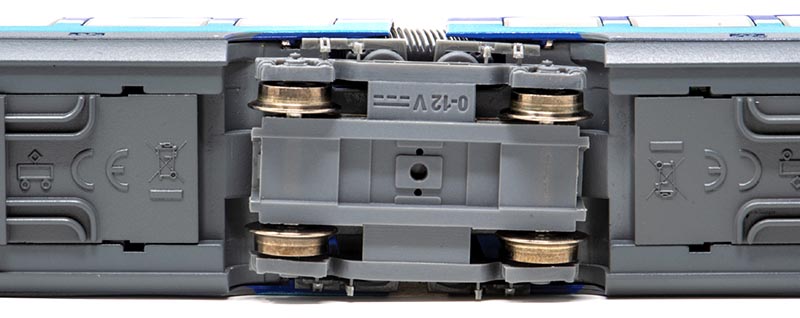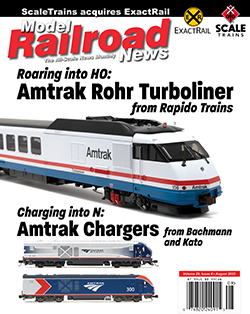Mass transit modeling took a step forward with PIKO America’s release of its HO-scale North County Transportation District (NCTD) Sprinter commuter train. The impressive model is the second 1:87 U.S.-prototype offering from PIKO in recent years; the Whitcomb 65-ton diesel switcher (“65 Tons of Blue and Orange Fun,” review in March 2023 Model Railroad News features this model). The Sprinter differs from the majority of modern North American commuter trains in that it is a foreign, single-level design adapted to U.S. “hybrid rail” standards. To this reviewer’s knowledge, this is the first time any model train manufacturer has released a hybrid rail commuter train in North America.
San Diego’s NCTD Sprinter is one of a handful of hybrid rail DMUs (Diesel Multiple Units) operating in the United States. Others are currently running in Texas, Oregon, California, and Washington, D.C. The term “hybrid rail” is a bit nebulous in the American railroad vocabulary. The Federal Transit Administration defines it as a “rail system primarily operating routes on the National system of railroads, but not operating with the characteristics of commuter rail.” Hybrid rail trains tend to be smaller, self-propelled commuter trains that do not meet U.S. government crashworthiness standards set by the Federal Railroad Administration, yet are allowed to run on standard railroads provided freight trains do not operate on the same tracks during the same operating hours as the hybrid trains. This is the case with the Sprinter.
The background leading up to Sprinter’s introduction began in 1975 with the establishment of NCTD’s predecessor agency, which was tasked by the State of California to consolidate public transit systems in northern San Diego county. After consolidating several city bus operations, the board turned its attention to rail, and in 1982 began planning for commuter rail service. A sales tax was passed in 1987 and subsequently extended through the 2030s, that helped fund the acquisition and upgrade of Santa Fe’s Surf Line and its Oceanside-Escondido branch, which had not seen passenger service since 1946.

While Coaster service began on the Surf Line in 1995, work on upgrading the Escondido branch did not begin until 2005, and was not completed until 2008. The entire 22-mile line was rebuilt from its junction with the Surf Line at Oceanside to its eastern terminus at the Escondido Transit Center. Welded rail, concrete ties, new ballast, new signals, and 15 state-of-the-art station platforms were installed from Oceanside to Escondido, along with a loop of track that serves commuting students at the California State University San Marcos campus.
When NCTD was looking for suit-able trains to run on the Escondido line, they considered domestic and foreign models and found Siemens of Germany’s “Desiro’’ diesel trainsets to work best. Desiro was already a proven design, with hundreds of diesel and electric versions operating in Europe. The lightweight construction, coupled with diesel-hydraulic drives, allowed for excellent acceleration and quick, quiet braking, which made them a natural for the Escondido line. A dozen articulated units numbered 4001-4012 were built in Germany and delivered to the U.S. in August 2006. Desiros were christened “Sprinters” and placed in revenue service in March 2008.
Since 2008, Sprinters have been earning their keep shuttling commuters, students, and tourists between Escondido and Oceanside. Each trainset presents a handsome appearance with aerodynamic bodies and striking gray/blue/white/green color scheme. The train’s airy interior features a low floor that matches each station’s platform height. Ample floor space allows room for wheelchairs, bikes, and strollers while large, tinted-glass windows allow for a full view of the passing scenery. Prerecorded messages welcome passengers at each station, announce each stop along the line, and provide information regarding riding the trains. Internet service, a much-needed amenity in today’s world, is available on each train. As is true for many commuter trains, there are no onboard restrooms.
Sprinter trains run on the half hour, every weekday from 4 AM to 9 PM in both directions. Weekend and holiday schedules are more relaxed. A $2.50 ticket buys the rider a one-way trip in either direction, with discounted fares for seniors and disabled individuals, while children under age 5 ride free. According to NCTD’s website, Sprinter trains carried an average of 7,865 passengers per day in 2019. While the Sprinters are geared for a top speed of 50 mph, they typically run about half that speed due to the many stops and grade crossings on the line. Often the trains run in pairs, but no more than two trainsets are coupled to each other for a run.
HO Sprinter
PIKO America has offered a European Desiro for several years as part of its Classic line. While they could have applied the Sprinter paint scheme on the hobby company’s Desiro tooling and called it good, they went the extra mile to offer an accurate reproduction. The main visual differences between the European Desiro and this NCTD Sprinter are large air conditioning units sitting atop each car. The main technical differences between European Desiro and this U.S. Sprinter are the inclusion of the new XP 5.1 SmartSound decoder which works with U.S. Digital Com-mand Control (DCC) systems, and the multitude of Sprinter-specific sounds; created for this release, and not just recycled European sounds…




